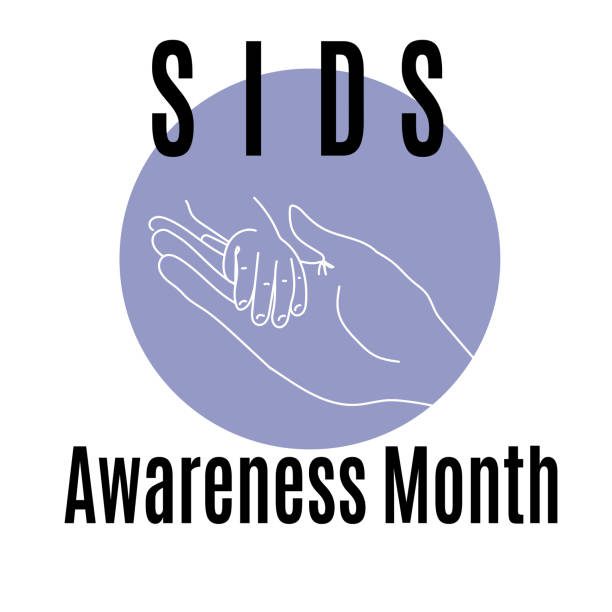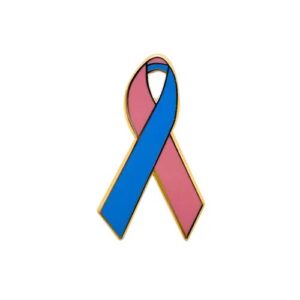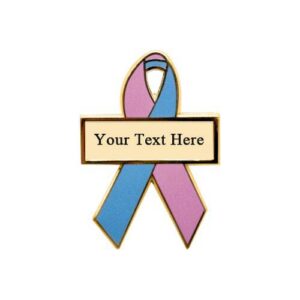
Sudden Infant Death Syndrome (SIDS) Awareness Month
Sudden Infant Death Syndrome (SIDS) Awareness Month is observed in October. SIDS Awareness Month is sponsored by the Eunice Kennedy Shriver National Institute of Child Health and Human Development. October is a time to take a fresh look at how we can educate parents and caregivers on reducing the risk of SIDS. Sudden Infant Death Syndrome (SIDS) Awareness Month brings awareness to SIDS, the sudden death of an infant less than one year old that cannot be explained after a thorough investigation that includes an autopsy, examination of the death scene, and a review of the medical history. Wear a pink and blue awareness ribbon pin to raise awareness for SIDS and Sudden Infant Death Syndrome (SIDS) Awareness Month. Personalized Cause offers both a personalized and non-personalized enamel awareness ribbon pin. This pin allows communication and support without saying a word.
Wear a Pink and Blue Awareness Ribbon Pin to Raise Awareness for Sudden Infant Death Syndrome (SIDS) Awareness Month
Spread the word about safe infant sleep during Sudden Infant Death Syndrome (SIDS) Awareness Month in October and year-round.
Ways to Reduce Baby’s Risk – Learn More During Sudden Infant Death Syndrome (SIDS) Awareness Month
Parents, caregivers, healthcare providers, and others have made great progress in reducing sleep-related deaths in the United States. By placing babies on their backs to sleep for all sleep times, creating a safe sleep environment for baby, and following other evidence-based recommendations from the American Academy of Pediatrics (AAP) Task Force on Sudden Infant Death Syndrome (SIDS), everyone who cares for baby can help reduce baby’s risk of SIDS and other sleep-related infant death, such as suffocation. It’s important for all caregivers, including parents, grandparents, aunts, uncles, babysitters, child care providers, and anyone who might care for baby to learn about safe infant sleep to help reduce baby’s risk.
Place Babies on the Backs to Sleep for Naps and At Night
- Place all babies, including those born preterm and those with reflux, on their backs to sleep until they are 1 year old.
- It is not safe to place babies on their sides or stomachs to sleep, not even for a nap. The safest sleep position is on the back.
- Babies who sleep on their backs are at lower risk for SIDS than babies who sleep on their stomachs or sides.
- If baby usually sleeps on their back, putting them on the stomach or side to sleep, like for a nap, increases the risk for SIDS by up to 45 times.
- Once babies can roll from back to stomach and from stomach to back on their own, you can leave them in the position they choose after starting sleep on their back. If they can only roll one way on their own, you can reposition them to their back if they roll onto their stomach during sleep.
Sleep Surfaces
- Both the sleep surface (such as a mattress) and the sleep space (crib, bassinet, or portable play yard) should meet the safety standards of the Consumer Product Safety Commission (CPSC). The CPSC offers more information about mattress and crib safety.
- Soft surfaces, such as couches, sofas, waterbeds, memory foam, air and pillow-top mattresses, quilts, thick blankets, and sheepskins are not safe for babies to sleep on. Babies who sleep on soft surfaces may not be able to breathe due to entrapment or wedging, suffocation, or strangulation. Learn more about other sleep-related deaths, including entrapment, suffocation, and strangulation.
- Inclined or tilted sleep surfaces, with one end higher than the other, are not safe for babies to sleep on because baby’s body can slide down and their head can slump forward. This could block their airway and breathing.
- Do not use sitting devices, such as car seats and strollers, or carrying devices, such as carriers and slings, for baby’s regular sleep area or for naps. If baby falls asleep in a sitting or carrying device, move them to their regular sleep space as soon as possible once you are out of the vehicle. The American Academy of Pediatrics offers travel safety tips, such as giving baby breaks from the sitting device every few hours.
- Avoid letting baby sit slumped over, like with their chin on their chest, because it could block their airway and breathing. Young babies and those unable to control their head and neck muscles risk suffocation and death from sitting this way.
- Keep comforters, quilts, pillows, and blankets out of baby’s sleep area.
Sleep Spaces
- Babies in their own sleep space are at lower risk for injury and death from SIDS and situations like an adult or sibling accidentally rolling over them.
- Room sharing by putting baby’s sleep space near but not in your bed is safer than sharing your bed with baby. It is also safer to share your room with baby than to put baby in their own room.
- Keeping baby’s sleep space close to your bed makes it easy to check on, feed, and comfort baby without having to get all the way out of bed.
- If you are bringing baby into your bed for feeding or comforting, before you start, remove or clear away all soft items and bedding from your side of the bed. This may help prevent suffocation in case you fall asleep. When finished, put baby back in their own sleep space close to your bed.
- If you fall asleep while feeding or comforting baby in your bed, put them back in a separate sleep area as soon as you wake up. Research shows that the longer an adult shares a bed with baby, the higher baby’s risk for suffocation and other sleep-related death.
- Couches and armchairs are never safe places for babies to sleep. These surfaces are extremely dangerous when an adult falls asleep while feeding, comforting, or snuggling with baby. Do not let babies sleep on these surfaces alone, with you, with someone else, or with pets.
- Sharing an adult bed, couch, or armchair with baby can be risky, especially in some situations.
Very high risk:
- The sleep surface is soft, such as a waterbed, old adult mattress, couch, or armchair.
- The adult is very tired, taking medication that makes them drowsy, or using substances like alcohol, or their ability to respond is affected in some way.
- The adult smokes cigarettes or uses tobacco products (even if they do not smoke in the bed).
High risk:
- Baby is younger than 4 months old (regardless of adult smoking or sleep surface).
- The adult is a caregiver other than baby’s parent, such as a grandparent or sibling.
Higher-than-normal risk:
- Baby was born preterm (before 37 weeks) or at a low birth weight.
- The sleep area includes unsafe items, such as pillows or blankets.
Learn more about creating a safe sleep environment for baby.



